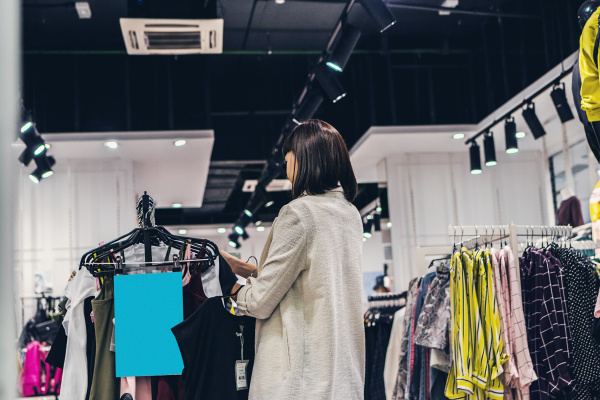
In this month's EU 1.5° Lifestyles blog post, we're thrilled to have Katia Dayan Vladimirova, Senior Researcher at the University of Geneva, as our guide to the impacts of social media on our choices, behaviors, and attitudes, particularly concerning (un)sustainable ways of consuming fashion. Katia highlights the overconsumption fostered by these platforms as well as the potential, if any, that they hold as catalysts for meaningful conversations about more responsible ways of living.
Over the past two decades, social media has evolved from being a fun way to keep in touch with former friends and family to a multi-billion-dollar industry that has profoundly changed our lifestyles, including how we communicate and learn, have fun and rest, shop and work. With almost 3 billion reported active users on Facebook, 2.5 billion – on YouTube, and 2 billion – on Instagram, around half of the global population are on social media, but likely more.
We turn to social media to get advice about anything from where to go on vacation or what phone to buy next to how to boil an egg or build a bunker on a budget (no kidding, a very popular search!). To capitalize on this new information space, businesses moved into social media to promote and then, eventually, sell their products and services. The rise of “influencers” – social media personalities with significant reach (in terms of numbers of followers) – was coupled with the growth of paid promotions of products sponsored by brands. Influencers use trust of their audience to help brands sell more, for a modest fee of ca. 6 billion USD in 2023. The emergence of the term “social commerce” – selling goods and services directly through social media platforms – signals the complete merger between the “social” and “commercial” aspects of these platforms. Most projections around these platforms come from market research firms – and are remarkably rosy and optimistic in terms of future expansion.
At the same time, social media is also home to discussions and learning communities interested in more sustainable ways of living. Free educational resources, step-by-step guidelines, video / audio / image / text-based advice on pretty much any topic can be found online today. From foraging communities to upcycling clubs, manifestations of more sustainable practices can be traced on social media. These communities offer knowledge, motivation, and support of peers to encourage changes towards sustainable lifestyles. Despite their importance, social media communities have been notoriously difficult to study from an academic standpoint – which is why we are lacking research in this area. The evolution of private data protection and missing tools for collecting significant data sets have all been slowing down this field of research and keeping it small-scale.
On fashion consumption, sustainable and not so much
How we buy clothes in the Global North has changed a lot in recent years. For decades, the fast fashion system has been driving wanton overconsumption and impulse purchases by frequently changing display windows of fashion boutiques, rotating merchandise inside the store to create an impression of newness and adding new stock as often as every week. As brands promoted novelty-seeking behaviour among consumers, a culture of disposable fashion replaced that in which clothing, shoes, and fashion accessories were considered an investment, bought much less frequently than today, and were well taken care of and used for a long time. As a result of oversupply of affordable options, by the second decade of the XXI century, Millennials and Gen Z consumers also lost important skills of mending and repair that were passed from generation to generation.
When the COVID-19 pandemic hit, physical shops were closed, thus, limiting shopping options. For a brief moment, overall consumption of fashion dropped – but only to pick up towards the end of the pandemic. During the period of forced closure of brick-and-mortar stores, e-commerce leaped forward, propelling the so-called "ultra-fast fashion” brands, which sell exclusively online. Perhaps one of the most discussed ones is SHEIN, a Chinese brand that sells more clothes and fashion products than Zara and H&M combined, which produces in small batches and releases as much as 30,000 styles per day on their app.
In a new era of social commerce, fashion brands are actively capitalizing on social media users’ personal data to drive sales up. Recently SHEIN has been recognized as the worst offender among fashion brands using AI-enabled prediction algorithms that feed on user data and fall under the definition of “dark patterns” – mechanisms that are designed to manipulate internet users to spend more money and give away their personal data. Meanwhile, influencers promote “hauls” – videos featuring them opening bags of clothes and fashion products from sponsor brands, which creates the impression of constant renewal and celebrates novelty-seeking among their followers. A narcissistic culture of social media fashion and beauty influencers has been criticised also for creating unrealistic body image and lifestyle expectations and instilling feelings of inadequacy, especially among the younger followers. Social media, without a doubt, is fuelling overconsumption of fashion – and a mental health crisis.

A recent study by nine members of the International Research Network on Sustainable Fashion Consumption analysed what is researched about social media influences on our fashion consumption patterns, through a literature review of 92 academic studies. Unsurprisingly, the majority of scholarly work comes from a marketing perspective: 56 papers were about brand-related communications (aka How To Sell More Stuff).
Direct brand to consumer communications, user generated content (reviews) and electronic word of mouth discuss strategies how to better sell "sustainable fashion" to consumers. Brand "communities" are a big thing – brands invest in creating a sense of belonging and relationship with their clients. To enhance loyalty and convince clients to spend more, of course. Some interesting nuances came up, about "shallow" and "deep" social media involvement - through likes and comments, respectively. And of course selling products through influencers - a trend that is dying out right now with all the influencer fatigue and deinfluencing trends. But a whole 25 papers talked about what kind of influencers sell stuff better. To save you the trouble of reading through: attractive influencers sell more stuff.
However, the study also found important conversations about non-brand-related communications. There were a few papers that discussed activism, anti-consumption and sufficiency, as well as adoption of alternative consumption practices, like buying second hand, rental, or swapping. We see that, along with influencers who are used by brands to sell stuff, there are also those who educate, share their transformational journeys, and question the system. Some sustainable fashion blogs and accounts offer important information to those who want to experiment and learn, they organically form online learning communities where people stay not to get advice on what to buy but to get inspired and motivated to live more responsibly.
This study confirms the findings of another project that looked at discourses on sustainable fashion on Instagram. Interestingly, the loudest voices – in terms of shallow engagement through “likes” – to speak about sustainable fashion on this platform (favoured by Millennial women) are H&M and Reliance (largest producer of polyester from India). Corporate capture of the discourse makes it shallower, with short captions and hashtags that are not explaining or even mentioning the sustainability credentials of the product. On the contrary, the most important conversations that generated deeper forms of engagement through comments were held by influencers who actively discuss systemic issues of the fashion industry, including inequalities, pollution, overconsumption, and the questions of race and neocolonialism.
To summarize, social media is a mirror held against our society. It is not intrinsically good or bad - it merely amplifies the influences and aspirations that are already present and magnifies them. Social media platforms represent an important – if not the main – space to promote and enable sustainable lifestyles. Learning communities can play a critical role in advancing these conversations, across national borders, classes, and income groups.
If you want to read more about the role of media as drivers of fast fashion consumption, as well as how to rethink fashion for a fair consumption space, explore the Unfit, Unfair, Unfashionable Report from the Hot or Cool Institute.
Dr. Katia Dayan Vladimirova is a Senior Researcher at the University of Geneva working on the topics of systemic change, degrowth and sufficiency in fashion. She is the Founder of the International research network on Sustainable Fashion Consumption.

